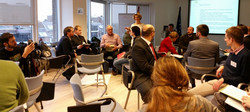EU researchers explore pathways for transition to sustainable lifestyles
How can we begin to live more sustainably? How does time use influence our consumption patterns? Is environmentally sustainable growth actually feasible on a world scale? These are just some of the important questions that societies must address as we attempt to move towards a more sustainable future. The new FP7 GLAMURS (‘Green Lifestyles, Alternative Models and Upscaling Regional Sustainability’) project is exploring these and other issues with the ultimate aim of supporting policymakers, businesses and citizens to make the right decisions to help create a sustainable future. Using methods such as knowledge co-production, agent-based modelling and macro and micro economic modelling, the team will try to evaluate transition models of lifestyle change in terms of economic and environmental effects and provide recommendations for a pathway forward. Just last week GLAMURS held a workshop in Brussels in order to begin engagement with stakeholders and policymakers at the EU level. In his opening address to the workshop, project coordinator Ricardo Garcia Mira from the University of A Coruña in Spain explained how the interdisciplinary project team, comprising economists, political scientists, social scientists, engineers and others, will carry out research in two phases. The first will involve seven case studies covering Spain, the UK, Romania, Austria, the Netherlands, Italy and Germany to provide an empirical basis for research and nurture an understanding of how transitions to sustainable lifestyles and green economies are possible. The second will see the team testing alternative lifestyle trajectories and systems of production and consumption for macro and micro economic effects. GLAMURS, which launched in January 2014, will then offer recommendations to regions and as well as suggestions for upscaling to transitions beyond the regional levels. Speaking at the meeting, Domenico Rossetti, European Commission project officer for GLAMURS framed the project within the overall European context: ‘The EU energy bill amounted to EUR 400 billion in 2012 - more than three times the EU budget; the EU is importing 55 % of its energy needs (90 % for oil) […] and 40 000 people die in road traffic in the EU’. These statistics represent unsustainable patterns that the EU is attempting to tackle with new targets announced in late October, including a cut in greenhouse gas emissions by at least 40 % by 2030 compared to 1990 levels and an EU-wide binding target for renewable energy of at least 27 %. GLAMURS, along with projects like EU-INNOVATE and POCACITO, will contribute to these efforts. Mr Rossetti pointed to the standout features that combine to make this a unique endeavour: ‘There is a forward-looking dimension, the team is using both qualitative and quantitative methods, it’s ambitious but realistic and it’s innovation-oriented.’ Mr Rossetti noted that the work of GLAMURS and others contributes to a ‘B-GOT’ approach – Beyond GDP, Beyond Oil and Beyond tangibles. A significant aspect of the GLAMURS project is that it focuses on a time-use approach. Adina Dumitru, GLAMURS researcher from the University of A Coruña, elaborated on this point: ‘We want to look at the influence of time scarcity on consumption-intensive activities … We have observed that more consumption-intensive lifestyles have not led to more affluence and wellbeing. Time affluence supports life satisfaction while being materially affluent [above a certain level] does not.’ The team will explore how acceleration and time pressure relate to consumption, pro-environmental and community activities and sustainable/unsustainable lifestyles. To get to the heart of the issue, Ms Dumitru, and her colleagues will organise focus groups in the case study regions and carry out in-depth interviews. On a quantitative level, they will conduct regional surveys. Gary Polhill from the James Hutton Institute in the UK provided an early glimpse of the type of agent-based modelling through computer simulation that will be used in GLAMURS. The sample model focused on commuters going to work in the morning and the inevitable traffic jams that build up. Mr Polhill explained how the team used this topic to explore simple solution scenarios, for example allowing more flexible working hours, building new roads and improving car technology. By the time that GLAMURS reaches completion in December 2016, Ricardo Garcia Mira hopes that it will have achieved its ambitious aims: ‘We expect to provide policy-makers, practitioners and other relevant stakeholders with recommendations and practical tools that would help them steer lifestyles in a sustainable direction. And we hope to show different pathways for economic change that would ensure a sustainable social, economic and environmental society in Europe and beyond.’ For more information, please visit: GLAMURS http://www.glamurs.eu/
Countries
Spain



